Tune In, Turn On
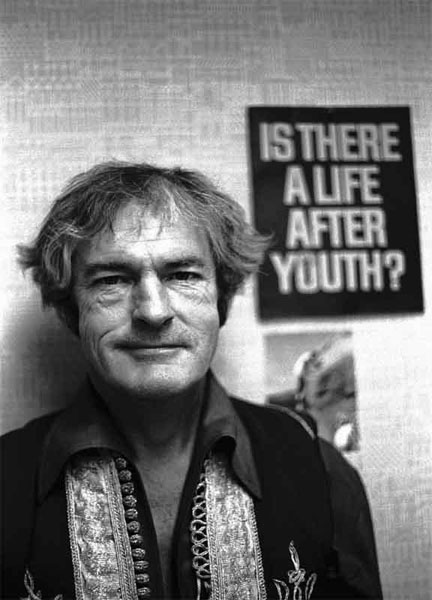
If you are of a certain age, you will remember Timothy Leary with a mixture of fascination, awe or disgust. He was the High Priest of Acid, the original Turn On, Tune In, and Drop Out. He was an icon of the age, and the subject of the Moody Blues song “Legend of a Mind” that drifts still through my memory:
Timothy Leary’s dead.
No, no, no, no, He’s outside looking in.
Timothy Leary’s dead.
No, no, no, no, He’s outside looking in.
He’ll fly his astral plane,
Takes you trips around the bay,
Brings you back the same day,
Timothy Leary. Timothy Leary.
I was ruminating about Leary, and his role in the Mary Pinchon Meyer affair, reading Peter Janney’s strange narrative in my brown chair by the window, left leg elevated and ice on the knee. I had to put down the iPad twice to field telephone calls, cursing that I had not moved all my electronic devices to the coffee table where I could get at them without getting up.
The first call was a report from my on-the-ground correspondents in Ann Arbor, Michigan. It was the first Saturday of April, and the 41th iteration of the Hash Bash, a celebration of civil disobedience conducted at the central campus diagonal crossroads of the DIAG.
Let me go back. I was on campus for the first of the Bashes, a motley gathering of students protesting the arrest (and conviction) of local White Panther Party activist John Sinclair over the distribution of two marijuana cigarettes to an undercover agent.

John got ten years at Jackson Prison- nine and a half, actually, and his unexpected release came two days after a huge “Free John” benefit concert at Crisler Arena- the basketball venue called “the House that Cazzy Built” after the remarkable collegiate career of Wolverine Cazzie Russell, who led the Maize and Blue to three consecutive Big Ten Championships and two appearances in the NCAA Final Four.
Headliners at the concert were former Beatle John Lennon and Yoko Ono, backed up by Stevie Wonder and Bob Seger and Commander Cody and his Lost Planet Airmen. It was nuts- quite intoxicating to have that sort of star power supporting a local activist and musician.

(The Free John Concert. My pals and I are at the upper right someplace.)
The Arena opened in 1967- the year Detroit burned after the 12th Street riots. The time is a bit of a jumble now, with so much water over the dam. I got to Ann Arbor in the fall of 1969. It was a pretty crazy time to be living just about halfway between Plum Street, the Haight-Ashbury of the Motor City, and the White Panther Party headquarters at 1520 Hill Street. From the Chi Phi fraternity where we lived, you could have hit the WPP HQ with a well-thrown baseball.
You might think that this would be a long way around the rosebush to talk about Tim Leary, murdered socialite and Presidential lover Mary Pinchon Meyer and her estranged former husband and CIA honcho Cord Meyer, but it isn’t, really.
That was the subject of the second call I got Saturday. My pal Mac called to relate something about Operation Mockingbird. ”
You certainly covered a span of time — well over half a century,” he said. “The only survivor of the names you introduce may be Washington Post Publisher Ben Bradlee.” He paused in recollection. “I used to see Cord Meyer trudging the corridors of CIA when I was there in the 70s. Angleton was sneaking around also- you know I was there when Bill Colby fired him.”
“That is incredible, Admiral,” I said, doing a Kevin Bacon degree of separation between him and me and Cord Meyer.
“But they’re all gone now, the good-maybe- and the bad. The only one I didn’t know was the young lady who was murdered. I must have been soaking up Hawaiian sunshine when that happened, and the Honolulu papers didn’t report much from the Mainland. Was her assailant ever identified, found, or tried? Interesting history.”
“He was, and the conclusion is ‘maybe,’” I said, and I vowed I would get to the whole thing presently. In the meantime, I got sidetracked with the New York Times by Ben Stiel, who unravels the mystery of why an American did not traditionally head the International Monetary Fund, rather than The World Bank.
Simple, really. The architect of the Bretton Woods Conference was Harry Dexter White, and the IMF was the centerpiece of his vision for the post-war economic order. He was the likely candidate to head the new institution. There was a problem, though. Harry Truman was made aware of allegations that White had been an active Soviet Agent for years.
As an outcome, Belgian Camille Gutt, became the first head of the IMF and an American- not White- became the first head of the World Bank. It is interesting how the past informs the present, don’t you think?
I am not going to get to who killed Mary Pinchon Meyer today. There is a lot of interesting ground to cover to get there, and I assure you I have no revealed truth about anything. But it is worth showing the intersection between our external foreign intelligence service and campus life, and John Sinclair before we get back to Mary and her Presidential lover.
I have to explain some of the downstream consequences of a decade that unraveled starting the day Ike left office. In 1968, there was a discrete CIA recruitment office at 450 Main Street, Ann Arbor, Michigan, in those days. No one actually appeared to work there besides a receptionist, who would inform the curious that John F. Forrester, the Chief of Station, was not in the office. It was a bit like seeing Major Major in Heller’s Catch-22: if the Major was there, you could not see him. If he was out, you could go right in.
On that night in late September, someone set off four to six sticks of dynamite in front of Forrester’s office. The explosion was powerful, though nothing along the lines of the IED’s that have become so fashionable of late as a means of political expression.
The blast shattered windows and caused thousands of dollars worth of damage to the taxpayers. A few weeks later, the Institute of Science and Technology on North Campus was targeted. It was rumored to be an Air Force research facility, but of course that rubric could be used for all manner of things, including DoD support to the Agency.
The effort to find those responsible for the bombings targeted the avowed revolutionaries of the White Panther Party. Tipped off by a government informer, a federal grand jury indicted three members of the Panthers for the bombings. Defense Minister “Pun” Plamondon was a hippy from Traverse City. He was charged with having set off the bomb, and White Panther Minister of Education Jack Forrest was charged with conspiracy, along with Minister of Information John Sinclair.
When the indictment was handed down, Sinclair was already in prison, though his fame had spread internationally, and the big concert at Crisler Arena cemented his fame as a political prisoner. Pun Plamondon went underground for nearly a year to pleasure spots like Algeria after hearing about his the indictment on the radio. He even made the FBI’s Ten Most Wanted list, which he thought was pretty good for an average kid from Traverse City.
It is a pity, really, that DCI Richard Helms directed all the files on MKULTRA be destroyed in 1973, ahead of the Rockefeller Commission’s investigation of the Agency’s clandestine experiments with psychedelic drugs. The Agency had distributed more than 300 grants for study of the impact of mind-altering substances on unwitting subjects.
That is how I wind up back on the towpath of the C&O Canal, looking dimly back through the years at the sprawled body of Mary Pinchon Meyers, and the impish figure of Dr. Timothy Leary. We don’t think of Tim Leary, high priest of acid, as a World War Two vet. He was, and even a West Point Cadet before he tangled with the honor court.
He wound up as a sergeant in the Army Medical Corps, and that is how Tim became associated with Cord Meyer, a decorated combat Marine who was blown up by a Japanese grenade on Guam. Do you remember that there were competing Veteran’s groups to the American Legion and the VFW? The American Veterans Committee directed a front group of the Communist Party (the AVG) that sought to harness returning servicemen to the one-world solution to the elimination of all wars.
Cord Meyer was one of the leaders of the organization, and with published work in The Atlantic, Cord’s patrician background and extensive connections with The Right People had people thinking he might be a contender for the Presidency of a future World Government.
The organization swelled to more than a hundred thousand members before the Korean War broke out, and the brief illusion of a UN-led world shattered on the rocks of the reality of the USSR and the DPRK. Membership diminished in the wake of the revelations of the House Un-American Activities Committee about the extent of Communist penetration of the US Government. Cord Meyer was disenchanted with the AVG, and needed a job. He got one from Allen Foster Dulles at CIA, who was busily filling a bench with the best and brightest from the Ivy Leagues.
That is where Cord wound up, working first for Frank Wisner, and then being put in charge of things like Operation MOCKINGBIRD. He was also involved with MKULTRA, a program with its roots in the attempted exploitation of the U-Boat crews and other Germans who wound up in the Camp That Did Not Exist down at Fort Hunt, known then and now as “Post Office Box 1142.”
It grew. Operation PAPERCLIP (and the parallel Navy scientific collection missions in Europe) not only brought V2 scientists, but others, who had used concentration camp inmates for human experimentation.
Anyway, that is how the very strange story goes, as related by Leary, about Mary Pinchon Meyers and her attempt to organize a cell of well-placed Washington ladies to turn on and tune in their powerful husbands. For Mary’s part, the story goes that she smoked two joints with President Kennedy, and got him to try a mild dose of LSD. He reportedly looked out the Truman Balcony of the White House, impressed with elements of the remarkable view that had not been apparent before.
MKULTRA was proceeding apace as well, and continued right up through the time that Mac arrived at CIA.
I do not claim to know who killed the President of the United States, though it is plain enough to me on viewing the famous Zapruder film that JFK was hit from fore-and-aft.
That, in turn, means the existing narrative requires alternation, and that there was a conspiracy to commit political murder by persons unknown. I also do not know if his alleged lover actually was trying to expand his mind and consider Tim Leary’s expanded consciousness in the context of the great struggle with the Communists, nor if Mary was murdered in an attempted rape or robbery, or if elements of the Government deemed her a person who knew too much.
It is all so queer, the way people died and their papers, diaries and records seemed to disappear.
Marylyn Monroe, for one. That is still a very strange sidelight to a very strange story. Dorothy Kilgallen, for another, the game show panelist and journalist who interviewed Jack Ruby in his jail cell. Her body was found holding a book she had already completed, and she was not wearing her reading glasses. She said she would blow the lid off the Ruby story. Her notes seemed to have got lost. And of course, Mary Pinchon Meyer and her detailed diary of what she had been up to in Georgetown before and after the assassination of her paramour. James Jesus Angleton seemed to have wound up with the diary.
Curious, don’t you think?
We will have to talk more about that tomorrow. Those were some really strange days.
Timothy Leary’s dead.
No, no, no, no, He’s outside looking in.
Timothy Leary’s dead.
No, no, no, no, He’s outside looking in.
He’ll fly his astral plane,
Takes you trips around the bay,
Brings you back the same day,
Timothy Leary. Timothy Leary.
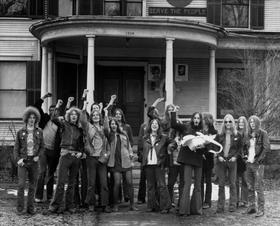
(1520 Hill Street, Ann Arbor, with White Panthers and the MC5.)
Copyright 2012 Vic Socotra
www.vicsocotra.com
To Kill a Mockingbird

(Mary Pinchon Meyer on assignment for Mademoiselle Magazine).
I made it to morning, and if the Lord has risen once more I cannot testify by personal vision, though I can say that it certainly seems reasonable. Life is singing with the sound of the birds outside.
For those who expressed concern yesterday, I did the right thing and stayed off the knee. It was a battle between cabin fever and good sense, and I took the enforced down-time to read Mary’s Mosaic, a most curious account of the murder DC socialite and JFK lover Mary Pinchot Meyer by Peter Janney, the son of an aristocrat of the old CIA- you know, the Princeton kind that were in shorter supply when I knew the good folks at Langley.
It is a well-written book, but like all the stuff about the Kennedy era, it comes with a whiff of hallucinogen. Timmy Leary appeals in the story, too, so you know it is weird.
“Woman Dies In Robbery On Towpath” is how the Washington Post covered Mary Pinchon Meyer’s death. But it was already weird. The police had made no identification of the body- that was supposedly provided by then-Newsweek Washington correspondent Ben Bradlee, Mary’s brother-in-law. But people in town already knew. Although he did not testify to that then, Bradlee talked about a mysterious phone call- possibly from Counterintelligence Chief James Jesus Angleton- while the DC cops were just arresting the man they would try for the murder- Ray Crump, a day laborer from Anacostia, way out of his neighborhood in Georgetown.
Mary was, in the words of family friend and investigator (and maybe the son of one of the people responsible for her death- his opinion, not mine,) Peter Janney:
“Mary was a free spirited blonde in her early forties, she was the product of the eccentric, blue-blooded Pinchot family. After divorcing the brainy, intense CIA propaganda master Cord Meyer, she had refashioned herself as a Georgetown bohemian, setting herself up as a painter in a studio behind Ben Bradlee’s N Street house.”
Cord Meyer was a complex man: a wounded-in-action-Marine, one-time pacifist and director of CIA’s media influence operations.
Mary was a progressive all her life. Cord came to political activism after he got back to CONUS and recuperated from his wounds. Mary came to her views through Vassar by way of her conservationist family, whose patriarch was a two-time governor of Pennsylvania. Cord came to it as a wounded Marine hero from the battle on Guam. He lost an eye, and was horrified of the implications of the use of the Bomb.
Both knew Jack Kennedy. Mary had first danced with him as a teen and JFK was a Choate preppie, and then they were all at the Alger Hiss-chaired San Francisco UN Conference.
It is amazing to see all the Cold War names in one small place: JFK and Jackie, Frank Wisner, Richard Bissel, Joseph and Stewart Alsop, Philip and Katherine Graham, Clark Clifford, Walt Rostow, James Jesus and Cicely Angleton, Wistar Janney, Ben and Antoinette Bradlee all appear in the streets of Georgetown, at the cocktail parties and soirees off M Street and up the hill.
It was a different world then: painfully small.
There was a lot of strange stuff going on. Frank Wisner, an original OSS Veteran, was establishing Operation Mockingbird, which may or may not have been the real name for the Langley operation that intended to suborn journalists in the name of national security.
In my day we called a similar still-born effort in the days after 9/11 “Strategic Influence Operations” before the term went quickly out of vogue when it appeared in the papers. That was as close to being named in the Washington Post as I am likely to come, and was lucky to escape unscathed.
After the story broke in 2002 about the existence of the office, Don Rumsfeld had to shut it down, muy pronto, while denying the whole thing had ever existed as anything but a concept. There were apparently memories longer than ours in town.
I was interested to learn that some of the people with the most liberal anti-conservative credentials- like Ben Bradlee of the Washington Post- had been up to their necks in “Mockingbird.” It was all very curious.
I don’t know if it is all true or not. I am not particularly surprised if it is, and a variety of blue ribbon commissions and panels down through the years have issued so many astonishing things that the Agency was up to that it is convenient to just chalk anything up to their clandestine operations.
I don’t know, have no way of knowing, and frankly don’t want to know. But there is something that lingers from the seminal Bad Day in Dallas in 1963 that I have had a hard time getting past all of my life.
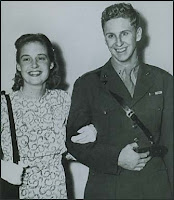
(Mary and Cord in happier Days.)
I was trying to tell some vignettes of the Red Spies of the 1930s and 40s. Cord and Mary were very much one-worlders at the dawn of peace. Cord was working on a construct for global government before Alan Dulles asked him to come to the newly-formed CIA (or had be been spying against them?)
As far as progressive credentials go, there can be no more virtuous position than being smeared by Tailgunner Joe McCarthy, and Meyer became one of the Senator’s targets for his previous leftist sentiments (if true) even as he ran Operation Mockingbird with a slush-fund of astonishing dimensions.
He kept his clearance despite a row with J. Edgar Hoover, but he lost his wife Mary along the way as he drifted deeper into the orbit of the senior CIA. Mary was a free spirit, a hippy before hippies were fashionable, and the claim is that after she and Cord were done, she smoked marijuana and possibly dropped acid with the President of the United States.
That is the claim, anyway. You cannot say that Camelot doesn’t still have its share of wonders.
According to the two books I am reading about Mary Pinchon (Nina Burleigh’s “A Very Private Woman,” and Peter Janney’s hallucinogenic “Mary’s Mosaic”) Mary’s murder is either deeply entwined with the JFK assassination with a professional hit because she knew too much (Janney) or the work of a deranged man and had nothing to do with anything except bad luck and timing (Burleigh).
I am going to limit my speculation to identifying precisely where the murder was committed. I must have walked there dozens of times. That should be something knowable here in Washington, like the precise place on the sidewalk where Pinochet’s thugs gunned down former Chilean Ambassador Orlando Letelier in Sheridan Circle, or the box at Ford’s Theater where Booth got Mr. Lincoln.
The C&O Canal towpath is a peaceful place this morning, just as it must have been right before Mary Pinchon Meyer took her last walk l toward Fletcher’s Boat House on the Potomac. I may take my cane and try to hobble down that way this afternoon.
It is a nice day.
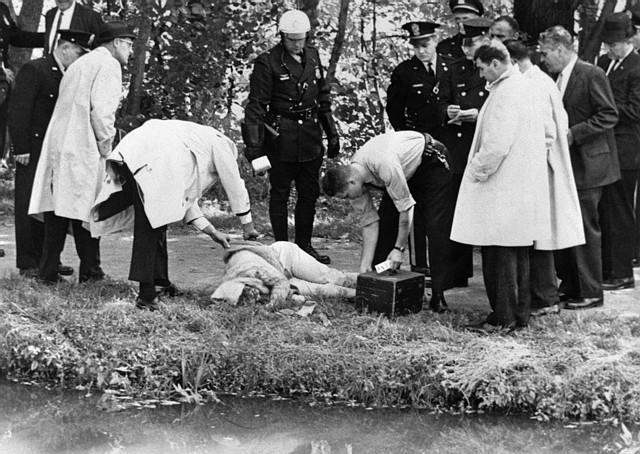
(Mary’s murder scene, 1964, with cops. Photo Washington Post)
Copyright 2012 Vic Socotra
www.vicsocotra.com
All Fall Down

I like baseball, and I like the ritual of opening day, and I have been following he new season with great interest.
I was planning to hook up with bro Spike and his son in Beantown and go to the Red Sox game at Fenway this coming weekend but I am not sure I can walk to get to the airport and onto the plane and off the plane and into a taxi and then hobble to the box seats in that magnificent ballpark.
But I am getting ahead of myself. I went to Willow, duh, which is how the week arrived at the dramatic fricking denouement. I went over at the usual time after work, which was unwise, probably, but I was meeting some people later and they didn’t show up until after seven, I was feeling no pain- literally- between the happy hour white and the great news about Tinkerbelle. The leg was much better.
Owner Tracy O’Grady came down to work the usual crowd and explained “that is it for the Lenten Fish Fry. Won’t be back until next year,” she said, and that made us all think.
Old Jim tucked into the fish, with luscious fries, and some boiled new potatoes, and Senior Executive Jeff looked envious and did the same. Pretty soon everyone was eating fish and loving it. My son showed up in uniform for a couple beers, and it was magnificent. I was feeling proud and expansive, along with Tink’s big news.
It was the last night of the Lent Fish Fry and it looked so good I almost fed myself, too, but I was feeling so good that I over stressed things coming back from the head to sit with the lovelies and went ass over teakettle near the kitchen entrance. I hauled myself up on the wooden divider to the dining room and wobbled across the slick wooden floor to my stool to finish what I gathered was going to be the last one of the night.
I tipped heavily- Tinkerbelle’s guy proposed the same weekend they found out she was pregnant and I wanted to be generous- and I got back in the Bluesmobile and managed to navigate home without further disaster.
Damn it hurt. I think I made a bulldozer of a vodka to kill the pain and actually made it to bed and was unconscious until after six. Unheard of, and man did the leg hurt when I put some weight on it.
Then the phone rang while I was cooking a lazy broiled-tomatoes-cheese-and-eggs breakfast and got into an intense discussion with an Indian call center who is trying to dun me for the Gold’s gym membership I don’t use, and which institution billed my credit card $20 a month for a couple years on the off chance that I would go and work out, which I didn’t, and when my credit card number changed last December they piled up four months worth of charges and the Indians bought the debt and now call me three or four times a day to try to collect, to which I responded by paying Gold’s direct, those worthless shifty bastards, and I was explaining what I thought of call-and-collection centers in Bangalore when alarm bells started going off and the smoke detector went crazy and explained to the nice man that my kitchen was on fire and I had to go.
I grabbed the cane and limped toward the kitchen to see the cheese-and-tomatoes on fire under the broiler and I wondered where the fire extinguisher was and almost fell again opening the door to the oven and finally got the fire put out without burning myself and then hustled to the smoke detector that was chirping like crazy and I didn’t want the neighbors calling the fire department and stood on tip-toes to get to the box and the pain shot up my leg as I ripped out the battery to shut the goddamn thing off and almost fell again and then limped to the door to the balcony and threw it open and then looked at the black sooty-oily burned bacon mess that had been my pristine white oven and started saying: “Goddamn it” and realized that in addition to dying of the avian flu or lung cancer or something else I might succeed in incinerating myself and that, my friends, is how my Saturday is unfolding.
How is your Easter weekend starting out?
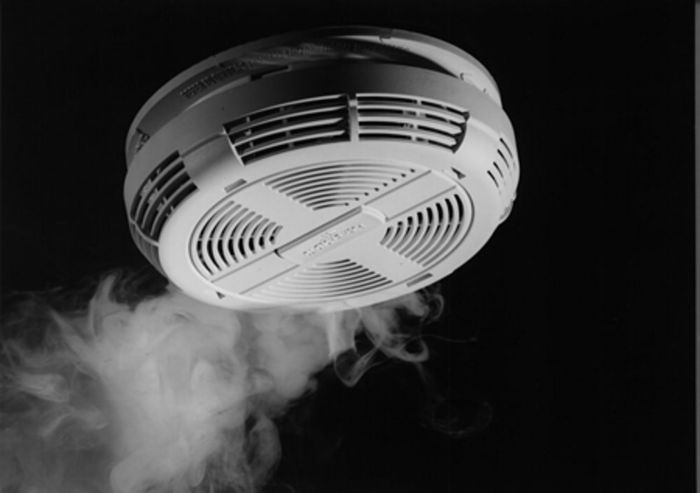
Copyright 2012 Vic Socotra
www.vicsocotra.com
Orbital Mechanics

(Patriot Advanced Capability-3 Missiles in box launcher. Photo courtesy US Army).
It was a lovely day in Arlington. We produce a lot of CO2 here, in the form of hot air being emitted from the various life forms of politicians, but it is a trace gas, after all, though possibly a contributor to the severe weather we have been having of late.
But there was no visible pollution in the air, temperatures were crisp but comfortable in a light sweater and shirt. The leg kept me shackled at the desk most of the afternoon, but it was pleasant enough looking out at the weather, and toggling on the computer to see the box score on the Tiger’s home opener in Detroit against the Red Sox.
I was gratified to see the messages pour in when the Tiggers managed to squeeze in a run in the bottom of the ninth, taking the opener 3-2 though an error kept ace hurler Justin Verlander from notching the win after a sparkling eight innings. I closed up shop, making piles of things to demolish on Friday, including a note to my partners that the stupid Judge had upheld the stupid protest by the pathetic company that couldn’t figure out how to get onto the base and was late in delivering their proposal.
The non-compliant cry-babies based their appeal on the fact that the government was stupid, too, and the judge was receptive. So the nonsense is going to continue through and took the elevator down to G-3 where the Bluesmobile was waiting in one of the handicapped spots.
I have Raven’s placard that is good through 2014, though he of course is not, and it has been a godsend during the recuperation from the stupid fall. Progress is being made day by day, and I considered walking over to Willow but decided the carbon footprint of the massive police cruiser would be insufficient to alter the arctic ice sheet and took the easy way out.
I found a meter just across Utah Street from the entrance to the bar and hobbled on over.
Old Jim was at his usual place, and Senior Exec Jeff was in mine next to him next to John-with-an-H. Jim was in his usual corduroy jacket and dark mock-turtle. John-with had clearly come from the office, and looked formally prep en dishabille. SEJ was definitely casual- open collar, suede jacket and a stubble beard.
“Work from home today?” I asked.
“Nah,” he said, sipping a tall glass of amber beer. “Flew in from London.”
“Man,” I said. “I love that town. What were you doing?”
SEJ smiled his wolfish grin. “Important meetings. Flew over on Sunday, got in and wandered around on Monday. Got my body clock right for the sessions that started Tuesday. Flew back today.”
“Arms must be tired,” said John-with, waving his happy hour red. No one responded to the ancient wheeze.
“And that means it is about 2300, body time, for you,” I said peering at my watch.
SEJ nodded, his silver hair fashionably long over his collar. “Yeah, I am beat.” He used to be an Army colonel, and I suspect he enjoys being free from the barber as much as I do. It is remarkable, I thought, our ability to jet all over the planet and still be at the local tavern at the end of the day.
He and John-with are in the counter-proliferation business for the government, and his cell went off with a strident ring-tone that mimicked an old-fashioned rotary-dial phone. He fished it out of his pocket and began to talk sotto vocce to an unknown party.
“Koreans or Iran?” I asked. John-with shrugged. “Must be the Koreans,” I continued, turning to Old Jim. “Apparently the North is going to try to launch a satellite in honor of Kim Il-Sung’s hundredth birthday. They are celebrating all month, opening power plants and crap. The missile launch is a celebration of their advances in peaceful rocket technology.”
“Assholes. Didn’t they say they were going to stop their nuclear program and work on ICBMs?”
“Yes,” said John-with. “That was intended to get us to continue food deliveries to keep their people from starving. Then they said they would launch a satellite anyway. Totally different than a missile to carry nukes.” He smiled with heavy irony and took a sip of wine.
SEJ ended his call and slipped the phone back in his pocket. “The office sends their love,” he said.
“You were a Russian specialist on active duty, right?” I asked.
“Yeah, I was a Foreign Area Officer. I had a lot of fun with the Russians. We toured the ”
“But all FAO’s have to qualify in combat arms first, don’t they? What branch were you?”
“ADA,” he said, straightening. “Air Defense Artillery. There is nothing that flies that I couldn’t shoot down. Started in Hawks and then Patriots.” We talked about the only species on earth- Fighter Pilots- who think otherwise. They are of the opinion that there are two types of airplanes- fighters and targets. “To me,” said SEJ “There are only targets up there.”
“What is the difference between fighter pilot and pigs?” I asked. SEJ shrugged, inviting the punch-line.
“You don’t see pigs in bars at two in the morning trying to pick up Fighter Pilots,” I said.
Everyone at the end of the bar groaned. “Did you hear the Japanese have deployed Patriot Advanced Capability-3 missiles to Okinawa? They want to be able to shoot down the North Korean rocket if they have to.”
“Doesn’t work that way,” said SEJ. “They could not engage in a boost phase intercept scenario.”
“Could they shoot the tankage from the boosters coming down?” I asked, surprised. “I thought the Patriot ruled back in the first Gulf War.”
“Not as much as they claimed at the time. It is all about orbital mechanics,” said SEJ. “You have to have your missiles deployed to the place you want to defend. The North isn’t trying to shoot at Japan, though they might shoot over a little part of it on a north-to-south trajectory.”
“What about the Navy Aegis cruisers? They shot down that Chinese satellite in 2008 with SPY-1 with the exo-atmospheric patch on the software and the Standard Missile-2 Extended Range Block-4 missile.”
SEJ sighed as only a professional can. “You Squids are too much. The patch just allows the radar to see things that are not targets. And there is no block-4. That program got cancelled when missile defense was cut back. And besides, they had three cruisers out there in the North Pacific and were lucky to get USS Lake Erie underneath the projected impact area, and it was a fuel tank, not a satellite. It was coming down anyway.”
“You don’t mean to tell me that was a stunt, do you?”
“Squids.” SEJ took a deep draft of his beer and waved as Jon-without-an-H arrived and attempted to negotiate a Black and Tan from the lovely Katya without much success. No Guinness, apparently, and the specific gravity of what she had behind the bar to concoct a B&T was as complex to negotiate as orbital mechanics. I asked him why he was drinking the beer mixture instead of his usual flavored vodka and iced tea.
“You gotta keep it mixed up,” he said, straightening his bow tie. “Need to stay fresh. I am sort of like the North Koreans that way.”
“They are crazy,” I said. “Did I tell you I got to King Il-Sung’s birthplace one time?”
Jon-without expressed mild interest, dividing his attention between the two vague shades of amber in his glass and the Great Leader’s nativity. “There are four of their submarines deployed, too. There are all kinds of crap going on.”
“When is this all supposed to happen?” growled Old Jim. “I may want to stay indoors.”
“Between the 12th and the 17th,” I said. “The Great Leader was born on income tax day, and some commercial imagery from Digital Globe shows they have oxidizing tanks on the launch pad and an Unha-3 rocket on the pad. The fuel is corrosive, so it is use it or lose it now.”

(Missile Defense Agency X-Band Radar platform. Photo MDA).
“They claim it is a Kwangmyongsong-3 satellite on top of the stack,” said John-with. “Purely peaceful purposes,” he smirked. “The Missile Defense Agency is deploying that crazy x-band radar platform to the region. This is a full production number.”
“That radar is supposed to be able to detect the stitching on a baseball at a hundred miles,” I said. “PACOM or STRATCOM must want all the data they can get.”
“Everyone has to look like they are doing something. It is a cover your ass drill,” growled Jim.
“The government is calling it highly provocative,” I said. “Even if there is not a lot we can do about it.”
“We can look busy,” said SEJ. “And that is about the best we can do unless they are shooting right at us.”
“Roger that. Sort of like holding a hand up in front of your face and daring the bastards to try to hit it. They never did declare peace on the Peninsula, after all. I guess we will just have to see how the orbital mechanics work out.”
“Squids,” said SEJ, and ordered another beer.
Copyright 2012 Vic Socotra
www.vicsocotra.com
Collective Wisdom
(New Soviet Man and Woman down on the collective farm).
I promised I was going to try to link the troubled history of the last century with this one. I don’t know if I am going to succeed in the amount of time we have this morning, but let’s have a go of it, shall we?
I had a long chat with the Professor Emeritus last night that helped me understand what is happening today, and realize why the institutions of our great nation are subject to such profound and consistently delusional behavior. The specific observations were about the American University system, but it is applicable to institutional behavior as far afield as the CIA and the Search for Saddam’s weapons of mass destruction. Group think.
You know what I am talking about. Things are so painfully correct these days that you have to be looking over your shoulder all the time. Any deviation from the collective line- whatever it is about, the latest terror from the HR department, who is awarded grants, the realty of Climate Change, political correctness, the nature of the cruel patriarchy, the historic evil of the West, blah blah blah, can bring career destruction.
The last things that held much interest for him as an educator were the meetings about tenure and promotion to full professorship. The tenure track is illustrative, that being the threshold for life-employment. It is the first big deal for the aspiring educator.
“We would see people apply for full Professor just a couple years after getting tenure. They don’t understand that the clock is re-set, and they have to generate more peer-reviewed papers. When tenure and full professorship is on the line, it is important that no deviation from the party line be tolerated. It was really a mess.” The professor sighed. He knew when it was time to go, he said, when recommendations from the Department Chairs, were shot down by opponents in other disciplines over issues that nothing to do with scholastic matters.
That review is similar to the US Senate’s unique system by which a single Senator can but an unspoken hold on nominations. It is a useful enforcement tool- and stifles free speech. Then we got onto my hobby-horse of Lysenkoism, since it appears to have risen from the dead and is walking around. I explained to him about the earnest Reds who thought the young Soviet Union was going to bring paradise to earth, and who were willing to betray their country to do so.
I told him about Hal Ware, the American Communist who spent the decade of the 1920s attempting to collectivize the agriculture of the New Soviet State, and that he could not have missed the misery that went along with it.
It is difficult now to convey just how awful the whole thing was. Even the CPUSA was a little uneasy about it, though it did not shake the faith of most of the true believers. Only the 1939 pact with the Devil in Berlin did that, and then only to a few who woke to the nature Uncle Joe’s ruthless interpretation of his interpretation of Marxism-Leninism.
Doctrine was important to the State, and that is where Dr. Trofim Lysenko enters the narrative. Born a peasant in the Poltava Oblast, he attended the Kiev Agricultural Institute. I can’t demonstrate that he and Hal Ware ever met personally, but they both certainly would have been at the Agricultural conferences on the formation of the Five Year Plan.
(A young Lysenko in the field, with wheat).
He came to fame in 1927, when the first plan was being formulated. At the tender age of 29, he was working at an agricultural experiment station in Azerbaijan. He discovered that by treating wheat seeds with moisture and chill temperature he could induce an early crop in the spring. Lysenko termed his process “Jarovization” to describe the low-temperature process to make the seeds of winter cereals behave like spring cereals. In the West, the term was translated as “vernalization” from the Latin word for Spring.
That might have worked- Lysenko moved so fast that there was never much time to actually validate what he was up to. He worked steadily through the great slaughter of the Kulaks. Hal Ware returned to the US shortly before it began, though there is no evidence that he voiced any disaffection with Stalin or his deliberate campaign to kill or relocate the hapless small farmers. We will never know. Hal was known to have a lead foot and a fondness for fast cars, and was killed on a Pennsylvania highway in 1935.
Later, however, Lysenko falsely claimed that a vernalized state could be inherited – i.e., that the offspring of a vernalized plant would behave as if they themselves had also been vernalized and would not require the treatment to flower quickly.
The fact that it contradicted collective wisdom in no way invalidated its appeal to Soviet policymakers. It promised something for nothing.
Defenders (he still has some) point out that his journal ‘Yarovizatsya’ ran an article in 1937 that stated:
“The discussion here is about securing the further development of geneticists from the point of view of development, securing the development of genetics as a science in place of converting genetics into a service of Goebbels. Only this will make it possible to convert such science into the highest stage that, at the moment, is in its primary stages of development. Only this will make is possible for our geneticists to earn respect of all the progressive scientists in the world. For the sake of clarity we repeat that Darwinism is not against genetics. Darwinism is for genetics. Darwinism is not against genetics but Darwinism is against fascist distortion of genetics and the fascist utilization of genetics in its political aims that are detrimental to the progress of humanity.”
By 1938, this distinct move from agronomy science to policy formation was complete, and Stalin made him the Chief Scientist of the Academy of Agricultural Sciences, he was entrusted with terminating the propagation of “harmful” ideas among Soviet scientists. Lysenko served this purpose by causing the expulsion, imprisonment, and death of hundreds of scientists. He also eliminated all study and research involving Mendelian genetics throughout the Soviet Union.
His predecessor at the Academy, Nikolai Vavilov, was a particular target of his wrath, and was jailed and died of starvation in prison in 1943.
It was all the rage in the USSR and East Europe thereafter to denounce non-mainstream thought as clear deviations from sanity. Confinement of such confused persons in mental institutions or the Gulag were natural extensions of Lysenkoism. It was truly an exquisite application of terror in a looking-glass world. Vavilov was rehabilitated, by the way, and an oceanographic research ship was named for him- one of the famous “Cluster Twin” ships of Vavilov and Lebedev fame.
Not that the refurbished reputation mattered much to him by then, but maybe the family cared.
Live by the sword, die by the sword. Lysenko survived the death of Stalin, but his quirky pseudo-science was denounced by a new generation of scientists in 1962, a time of great upheaval within the USSR, and redefinition of what really constituted the New Soviet Man.
In 1964, physicist Andrei Sakharov thundered against Lysenko in the General Assembly of the Academy of Sciences:
“He is responsible for the shameful backwardness of Soviet biology and of genetics in particular, for the dissemination of pseudo-scientific views, for adventurism, for the degradation of learning, and for the defamation, firing, arrest, even death, of many genuine scientists.”
It seemed at the time that Lysenkoism was dead, but everything old is new again. I mentioned Dr. Kari Norgaard the other day, the University of Oregon PhD in sociology who specialized in gender issues and tribal ecosystems. She is not a climate scientist, but is a fellow traveler on the road to saving the planet.
Her paper at the Planet Under Pressure Conference is a marvel of fuzzy group-think.
Any real system that values critical thinking would have blown her out of the water long ago. Instead, her observation that climate skeptics are mentally ill was met with deer-in-the-headlights silence by her peers and astonished disbelief by others.
She equated ‘cultural resistance’ to accepting humans as being responsible for climate change as a disease that ‘must be recognized and treated.’ It is aberrant sociological behavior. “Resolving skepticism about climate change alarmists,” she added, “is a challenge equitable to overcoming racism or slavery in the U.S. South.”
“In the last 30 years,” Norgaard said in outrage from the podium, “climate change has been seen as either a hoax or fixable with minimal political or economic intervention.”
Now, before you call, I personally am no ‘denier,’ as I think I have said fifty or sixty times. There has been a warming of almost a full degree centigrade in the last 140 years, and I am fully prepared to accept that man’s influence have something to do with the increase of a trace gas that constitutes .038% of the atmosphere. But I also remain skeptical about the impending doom thing, and the REALLY IMPORTANT imperative to scrap our national sovereignty and Constitution right away, just in case.
It is not only Dr. Norgaard. The party line is well established now, and I hear it like talking points from some committe. The version I heard on NPR a couple weeks ago went like this:
“Climate deniers are like those who want Creationism taught instead of Darwinian evolution. Deniers are paid by Big Oil and lavishly funded. It is run by the people who tried to defend cigarettes.”
I like the points- they are powerful, even if delusional. It starts with the term “denier,” which echoes powerfully the severely deluded who claim the Holocaust never happened. It is akin to the “birther” thing, a convenient shorthand for labeling political opponents crackpots- possibly dangerous ones- without precisely addressing the specific concerns. I lit up a Lucky and thought about it.
The lady who made the points on NPR seemed bemused that any right-thinking person could be associated with any skepticism of the notion of the re-branded Global Warming movement. I wrote them down, since I hear the same points emanating from a variety of sources who are really concerned that we are not getting on with global government, industry shut-down and divesting ourselves of our cars.
I would laugh it off is she had not been so earnest, and so many people had not agreed with her, and if I had not seen similar views in the Huffington Post and elsewhere. I even saw one in Playboy (I read for the pictures, but sometimes the articles get in the way) that argued there is actually a genetic predisposition to Blue and Red orientations- and it might be possible to “fix” it.
We are going somewhere very troubling these days. The climate thing is worth discussing in something less than apocalyptic terms- we can talk about what things like California’s experiment in unilateral cap-and-trade is likely to do to the Golden State.
But I do think it is interesting to look back in comparison to the generation who believed in the impossible change in human nature specified by the Communist vanguard, filtered through our generation of Boomers who had the arrogance to think we could change the world, here it is again, only with some uncomfortable quotations from some experiments in science that went very badly for a lot of people. Everything old is new, again.
“Calling Dr. Lysenko, Calling Dr. Lysenko!”
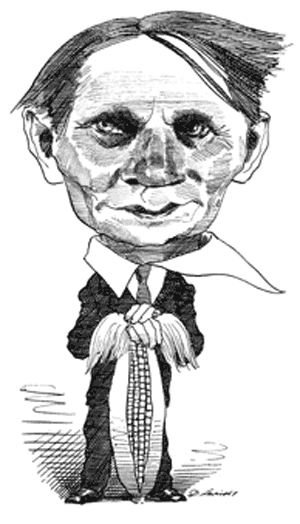
(The Good Doctor, from the New York Review of Books).
Copyright 2012 Vic Socotra
www.vicsocotra.com
Under Pressure
(Trofim Lysenko. Geneticist and Loon.)
I am going to tell you a story this morning. It is about history, and it is real. It is also true, if that means anything these days.
Oddly, I come to the same conclusions as one of the Moon Bats who populate the groves of academe. I mentioned Dr. Kari Marie Norgaard yesterday in passing, and she will be back in the narrative tomorrow.
It is worth talking about her fable, presented at the Planet Under Pressure Conference in London this week. She is not a scientist, though she does read about it as many of us do. She is a self-described specialist in gender issues and tribal environmental issues. She roams the outer limits of fuzzy social issues and applies them to scenarios of doom.
The Conference where she presented her paper was attended by people who have a fervent desire to save the world.
We talked the other day about how perfectly normal people with decent souls came to believe that the world was on the brink of disaster after the Great War, and that radical change had to be implemented to avoid catastrophe. Alger Hiss was one of them- a likeable, handsome young man who decided, without apparent malice aforethought, to join the Communist Party of the United States and then to betray his country.
There were many good people of his ilk. In no way do I assert that he was stupid or even ill intentioned. It is entirely possible that he considered himself and his comrades to be the vanguard of a brave new world that would eliminate injustice, inequality and the despoliation of rampant and voracious nationalism.
That is not to say that I do not consider him a traitorous fool. There are plenty of smart fools. Look around you.
(Harold Ware in his days at the Agriculture Department.)
One of my favorites of the smart, arrogant and desperately wrong-headed was a fellow named Harold Ware. Among other things, he ran a communist cell in the Department of Agriculture in the early 1930s, and at least for a time was the handler of Alger Hiss. That was before the Party determined that Hiss was a smart man on the rise, and that his connections to the espionage ring should be minimized to prevent his valuable career to be jeopardized. Ditto for Harry Hopkins in FDR’s White House, and Harry Dexter White at Treasury.
It was a slick operation conducted by smart people who harbored the belief that they could make a better world. I am not Red Baiting here- I am just telling the story the way it happened.
That was back in the day when association with radical progressivism was considered a negative career move. We have got beyond that. I mean, Communism is on the ash heap of history, right? The Cold War is done, we have all moved on.
This is a case study of how a smart, likeable guy wound up in bed with a Soviet Theorist. Not that there is anything wrong with that, mind you. I am a progressive myself. It was the Soviet who pioneered the idea that disagreement with the Party Line was an indication of mental instability, and the recommended course of treatment was confinement in a mental institution.
His name was Trofim Lysenko. He was a smart guy, too, like all these people. His specialty was biology, and specifically its application to agronomy. He was a visionary and mystical thinker who managed the scientific component of the famous Five Year Plans of the USSR.
With the passing of Lenin, Stalin assumed ever increasing central power through his position as the Party’s General Secretary. In the later 1920s, the Leninist New Economic Plan, as modified by War Communism necessitated by the civil war, contained some elements of a market economy. This was the topic of intense discussion between old Bolshies Bukharin, Tomsky and Rykov (who would take Lenin’s job), who favored the NEP, and the more radical Trotsky, Zinoviev and Kamenev. The former considered the existing construct to provide sufficient state control of the economy. The latter group believed that a great leap forward was necessary to wrest the Union out of poverty and industrialize at all costs.
The land of the former nobles has been confiscated by the Decree on Land, and nationalized under the 1922 Land Code. Collectivization of agriculture was established as the long-term goal, though due to the exigencies of the war against the revanchist Whites, peasants had been allowed to work the land with surplus production to basic needs being bought by the state at decreed prices.
The passing of the Land Code was a watershed in the advancement of the New Socialist State. A Bacon-and-Eggs American named Hal Ware was inspired to contribute his expertise to collectivization, and the improvement of Russian traditional agricultural methods. Hal came from a family of energetic and smart progressive people. His mother was a life-long community organizer and Socialist. He joined the Communist party in 1919 at its founding as a thirty-year old former professional farmer.
In his book “Witness,” Whittaker Chambers described him “as indistinguishable as everybody else. He stood about five feet nine, trim…with a plain face, masked by a quiet earnestness of expression wholly reassuring to people whom quickness of mind makes uncomfortable. Nevertheless, his mind was extremely quick….”
Ware might have been a progressive country agent or a professor of ecology at an agricultural college. And yet there was something jaunty about the flip of his hat brim and his springy stride. In 1921, Ware took a six-month trip around the United States to examine the plight of migrant workers, following the harvest from trail for six months through the South to the Midwest to the Northwest and then back east again through the Upper Midwestern states.
This experience, combined with his previous agricultural experience, cemented Ware’s place as the Party’s leading agricultural expert.
He packed up the family in 1922 and traveled to Russia to implement his vision for the soil, tenant farmers and increased crop production for the new Soviet State. Things in the prospective worker’s paradise were confused. Revanchists were still aboard in the land. Small farmers had yet to be consolidated. Elements of the old system had yet to be rooted out. Hal Ware was there to help.
Vladimir Ilyich Lenin died in January of 1924, and the14th Party Congress in Moscow the next year was the first time the new leadership did not have his guidance. Stalin was in the background, his preferred position, preferring to move with indirection. At the time he sided with the “moderates” of the Bukharin faction, but by 1927, had come around to the more aggressive statist stance of the Trotskyites.
Under his direction, the first of the Five Year Plans was commissioned in 1928. The point was the rapid industrialization of the Soviet Union. The smart people who wrote the plan recognized, however, that collectivization in agriculture was necessary to facilitate the creation of heavy industry. The creation of collective farms was the key initiative intended to leap-frog the old ways of small farms run by owner-operators.
These petite bourgeois farmers were known as “kulaks.” Stalin, and his fellow travelers correctly believed them as a class to be hostile to the regime and oppressive, in turn, to the poorer peasants who did not own land. Of course, under the Land Code, no one owned anything. The theory, compounded by smart guys, was that collectivization would improve production and benefit the serfs.
What actually happened was an exercise in the demonstration of unintended consequences. The terror inflicted on the working farmers, disruption of distribution, and lack of incentive made crop production collapse. All food and livestock were expropriated from the rural population.
“Famine was quite deliberately employed as an instrument of national policy, as the last means of breaking the resistance of the peasantry to the new system where they are divorced from personal ownership of the land and obligated to work on the conditions which the state may demand from them…” William H. Chamberlin, British correspondent.
Millions died, and the agriculture sector was in chaos. It was not in The Plan.
Something needed to be done. Stalin knew that urgent and desperate measures were called for. The Revolution itself was at risk.
(Hal Ware’s donated tractors helped collectivization. Trofim Lysenko provided the doctrine and theory.)
A smart Ukrainian scientist named Trofim Lysenko was just the man with the answer, and claimed he could radically increase production with dynamic new scientific methods. Stalin put him in charge of fixing the problem. The contributions of Harold Ware were useful to him, though they of course did not work. By the time of the famine, Hal was back in America, working at Agriculture. He was a smart guy, and people liked him.
It was too bad about that tendency he had to drive too fast.
I will have to tell you about that, and Dr. Lysenko’s remarkable career tomorrow. The hot water is out this morning at Big Pink, and if I am going to be fresh for the office, I need to be moving along.

(Uncle Joe looks on as Lysenko outlines The Plan.)
Copyright 2012 Vic Socotra
www.vicsocotra.com
The More, the Merrier

(Socotra’s offending left leg at Willow, with cane adjacent. Photo Jon-with-no-H).
I think I still have time to deal with the North Koreans, their prospective launch of an allegedly peaceful ICBM, the deployment of a really cool X-Band radar to the region by the Missile Defense Agency, and the prospects that the Japanese are going to use the SPY-1 Aegis radar system to identify and shoot down (with the Standard Missile-2 Extended Range missile) any parts of the rocket that are going to come down on the Home Islands.
The North, for their part, are said to be contemplating launching to the south, which any good missileer will tell you is dumb, since it sacrifices the inherent advantage of launching east, against the earth’s spin and harnessing all that free energy (1180 kilometers/hr. at the Equator) to the rocket’s loft.
Best of intentions and all that. The North is apparently not going to launch until the 100th anniversary of Kim Il Song’s birth next week (I will get around to the tour of the birth farm outside Pyongyang, I hope) so there is still time.
There are other loose threads, as I am sure you are aware. I have been beating up the players in the Great Red Scare of the early 1950s here in Our Nation’s Capital, and had a story going to talk about Harold “Hal” Ware, the Communist spy at the Agriculture Department in the 1930s. I was going to link him to the strange Soviet scientists and agronomist Trofim Lysenko (Ware did extensive consulting in the USSR during the liquidation of the Kulaks and collectivization of agriculture) and his wild-ass theories.
The upshot of which, in the looking glass world of State Socialism, became the notion that disbelief in Lysenko’s (and the State’s) theory of the moment was a reflection of mental illness, and hence deserving incarceration in the loony bin.
You cannot make this stuff up. You may have thought that the Evil Empire was consigned to the ash-bin of history, but Lysenkoism is back. It was the subject of one of the earnest papers presented at the Planet Under Pressure Conference in London, one of the preparatory conferences in which advocates of Catastrophic Anthropomorphic Climate Change fly all over the world to stay in posh hotels in glamorous cities spewing carbon to warn us that we have to make immediate and profound changes to society to stop spewing carbon dioxide.
My favorite paper at the conference was presented by Dr. Kari Marie Norgaard. She is a proclaimed expert in social and gender issues, who opines that those who are skeptical of Climate Change are ill, and need treatment.
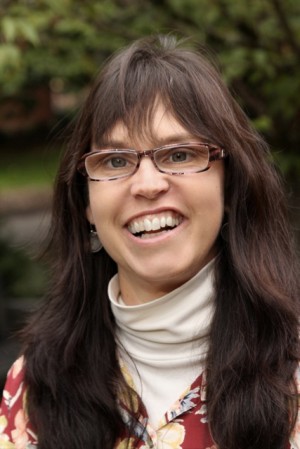
(Dr. Kari Norgaard, here to help the public health. Photo University of Oregon.)
That treatment would enable the public to more enthusiastically support profound and immediate social change to save the planet. That is not the first time I have seen non-climate scientists advance the bar on the discussion, but it is one of the more honest, if delusional.
Apparently Dr. Norgaard’s opinions are a little more progressive than the University of Oregon can handle, and the good doctor suddenly became a non-person back in the States. That was going to be the hook to a story linking Hal Ware, Lysenko and unsettled science as a vehicle for social change.
Oh, just for the record, I think the climate is changing. That is what it does. Whether my tepid enthusiasm for significant and immediate change warrants confinement I will leave up to the good Doctor.
Anyway, on the way to that I stumbled into something else. I have been conducting a vigorous dialogue with my attorney about the significance of the Red Menace and what it meant. He took umbrage at my treatment of the reality of the Soviet penetration of the US Government, and is of the opinion that the matter is a smoke screen for another land-grab by the national security-industrial complex to go to war with Iran.
I told him I was personally opposed to going to war with the Persians, though mostly because I had been at war with them for most of my professional career and was bored with it. To deflate the argument, I pointed out the marvelous LBJ article that was in the 02 April issue of The New Yorker.
LBJ Biographer Robert Caro has penned “a detailed account of the events of November 22, 1963,” the day LBJ became president through a hail of sniper bullets. I have not been able to not think of it since.
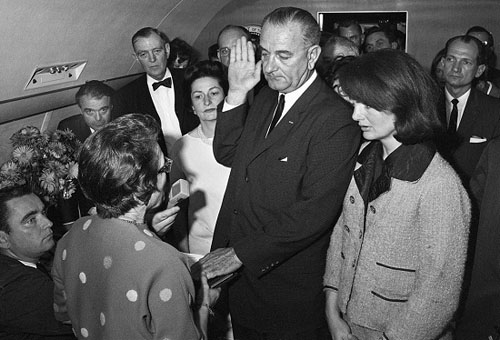
(LBJ being sworn as President of the United States.)
An abstract of his article says it: “Describes the shots fired at Kennedy’s car as the procession passed through Dealey Plaza. Tells about events at Parkland Memorial Hospital, where Kennedy died, and the decision by Johnson to go to Air Force One. Describes two telephone calls between Johnson and Robert Kennedy in the hours after the assassination. The dispute over the conversations later became a crucial element in the great blood feud between them. Considers why Johnson decided to have the oath of office administered in Dallas.”
I talked with Old Jim about the article at Willow last night, my first excursion outside without the knee brace, though with my trusty cane. Jim knew a lot of the players in town, back in the day, and it was a rollicking conversation.
We stayed away from whether the article did anything to contribute to the assertion of a mutual and respected associate who was in the government then that LBJ was behind the killing. There were several really strange aspects to the story. Caro brings a fresh approach to that awful day, a whole new perspective on things we thought we already knew. For example, at the very moment the gunfire erupted, LBJ crony Bobby Baker was being strongly questioned about corruption directly connected to the Vice President.
Anyway, as a footnote to all that, my attorney sent along his recollection of meeting Mr. Baker, back in the day when he worked on the Hill:
“I met Bobby Baker in DC when I worked there in summer 1966, either in Jim Delaney’s office or while running an errand over to the Senate. He was a DC dandy, with a pale fuchsia shirt, cuffs and cufflinks, gray-white hair turned up in locks at his collar like so many DC Dandies wear, a gold tie clasp and thin gold bracelet, and wearing strong cologne of some sort. As a young Paisan schooled in macho, I thought he might be gay.”
I wrote him back that I loved the commentary on Lyndon’s pal, and that I probably was not going to get to the New Lysenko-ists this morning. “Motive, Motive Motive,” I thought, and then the memories of the other stories came sweeping back. What a town this is.
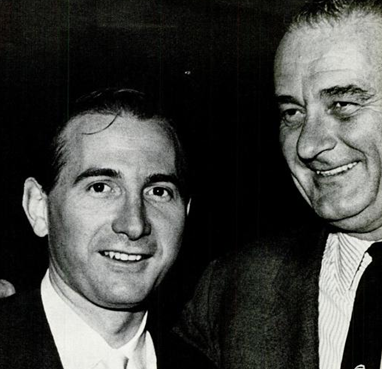
(Bobby Baker and his pal, Lyndon Johnson.)
Bobby Baker had come up through the Senate ranks, from page to assistant to the Majority Leader. He also ran the Quorum Club, a private facility located in the Carroll Arms Hotel, conveniently located adjacent to the Senate Russell Building.
In his 1978 book, “Wheeling and Dealing: Confessions of a Capitol Hill Operator,” Baker referred to the place where “membership was comprised of senators, congressmen, lobbyists, Capitol Hill staffers, and other well-connecteds who wanted to enjoy their drinks, meals, poker games, and shared secrets in private accommodations.”
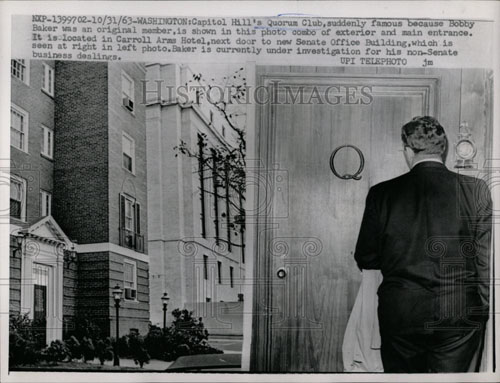
(Quorum Club picture- Carroll Arms at left, “Q” entrance at right. The photo is available on eBay).
I love this town. It used to be even more fun than it is now.
One of the women who frequented the Quorum Club was an eerie beauty named Ellen Rometsch, wife of a West German military attaché. She had been born in what was now East Germany.
Before the assassination, Director Hoover went to Robert Kennedy and said, “We have information that not only your brother, the president, but others in Washington have been involved with a woman at the Quorum Club whom we suspect as a Soviet intelligence agent, someone who is linked to East German intelligence.” The price of his silence was continued service as FBI director for Hoover- not the first nor last bit of Hoover blackmail against a sitting President.
(Ellen Rometsch)
RFK spoke with Senate leaders Ev Dirksen and Mike Mansfield and asked them to keep the report to themselves, and had the FBI files on the matter transferred to his personal custody and naturally sat on it.
Following the assassination, LBJ encouraged further investigation into the Rometsch case. Specific results were withheld, and files were destroyed or heavily redacted. More lost history.
Beyond Bobby, the story brought back some other characters of the time- Billie Sol Estes and Walter Jenkins.
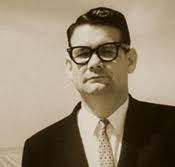
(Smooth-talking Billie Sol Estes.)
Estes was a trip- I remember well the scandal back in the day. As you may recall, he was a high-rolling LBJ associate and financier, who is still alive. In the late 1950s, he was heavily involved in the Texas Anhydrous Ammonia fertilizer business. He generated mortgages on nonexistent ammonia tanks by convincing local farmers to purchase them on credit, sight unseen, and lease them back from the farmers for the same amount as the mortgage payment, paying them a convenience fee as well. The fraudulent mortgage holdings were in turn used to obtain loans from banks outside Texas who were unable to easily check on what was actually in- or not in- the tanks. Nice piece of fraud, it was.
He also had an innovative (and equally fraudulent) scam on cotton that took advantage of Department of Agriculture subsidies to purchase large numbers of cotton allotments, by dealing with farmers who had been dispossessed of land through eminent domain. He convinced the farmers to purchase land from him in Texas and transfer their allotments there, with a mortgage agreement delaying the first payment for a year.
Then, he would lease the land and allotments back from the farmer for $50 per acre. Once the first payment came due, the farmer would intentionally default and the land would revert to Estes; in effect, Estes had purchased the cotton allotments with the lease fees. However, because the original sale and mortgage were pretexts rather than a genuine, it was patently illegal.
Eventually, the schemes collapsed and he went to the slammer for 24 big ones on charges related to the fraudulent ammonia tank mortgages. He appealed and got out after eight years, but almost a decade later he was again convicted on additional fraud charges and served four more years.
Congress held hearings into the matter and other Estes activities that led to the highest levels of the JFK Administration, specifically Lyndon, who had been a business associate with Estes in several matters. Some historians say that Kennedy may have considered dropping Johnson from the ticket in 1964, partly because of the Johnson-Estes connection, not to mention the Bobby Baker matter that was discussed in the New Yorker article- and happening simultaneously with the murder of the sitting President of the United States.
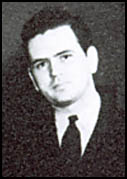
(Disorderly Walter Jenkins.)
And who could forget Walter Jenkins? That one resonated with the description of Baker, not that there is anything wrong with it. He began working for LBJ in 1939 when Johnson was in the House (D-TX-10) and was with him for the next quarter century.
Bill Moyers credits much of LBJ’s political success to Jenkins, but there are some things that could not be countenanced in the early 1960s. DC cops busted him in the rest room of the YMCA on “disorderly conduct” charges, which was the code-word for Senator (R-ID) Larry Craig’s “wide stance” cruising. Ick.
Jenkins and his partner were booked, convicted and fined $50. The incident caused a minor furor, and was attributed by an embarrassed Administration to stress and overwork. That did not serve to defuse the matter, though it even tried “combat fatigue,” since Walter had been a soldier in the war two decades before.
It didn’t work. The papers and Republican operatives would not drop the matter with a national election in the offing. Other walk-on characters in the scandal included almost Supreme Court Justice Abe Fortas and one-time SECDEF Clark Clifford who was the unofficial White House counsel at the time. I had a chance to interact with Clifford in his declining years when he made a call to me at the duty desk at the Bureau, seeking to have a pal interred at Arlington. (Nothing inappropriate was required of me, I was relieved to find. The pal wore the Silver Star and was entitled to the plot at the national cemetery.)
Anyway, friend or not, loyal retainer or not, LBJ told Fortas Jenkins had to go. When the matter was acknowledged by the White House, press secretary George Reedy was “openly weeping” as he confirmed the story to reporters.
Jedgar was in the mix again, too. Anticipating the charge that Jenkins might have been blackmailed, Johnson immediately ordered an FBI investigation. He probably knew about an earlier Jenkins conviction (1959) that the FBI should have known about (but didn’t?) The Bureau gave him a clean bill of health on the security front, and LBJ reportedly said later that he “couldn’t have been more shocked about Walter Jenkins if I’d heard that Lady Bird had tried to kill the Pope.”
The incident embarrassed the administration but had little impact on the campaign against Barry Goldwater. One columnist noted at the time that “Walter Jenkins has revived and dramatized all the harsh feelings about morals, and political cliques, and the Texas gang in Washington.”
Ware, Lysenko, Norgaard, Estes, Baker, Rometsch and Jenkins. Ah, those were the days, and apparently they still are! Let the games continue!
Did I mention I love this town?
Copyright 2012 Vic Socotra
www.vicsocotra.com
Reds Under Beds
I got a note from my attorney, inquiring if I was on strong medication. He wrote: “You sounded like Joe McCarthy on Oxycontin in that piece yesterday.”
I was at that moment on the cusp of creativity- or lack of it- as the darkness slowly melting away out the window, and fascinated by the forces that are abroad in the wide world these days. I hate Mondays. I had to grant my pal a significant point. I had a long rumination on the impact of Lysenkoism in mind.
(Trofim Lysenko, noted crazy geneticist. Photo courtesy of the Evil Empire).
You know, the doctrinal theme of the old Soviet empire that if you disagree with the State you must be crazy, and treatment included confinement in an mental institution.
There was some of that right here, too, in the Good Ole USA in the crazy days of the Red Scare. I decided to put Trofim Lysenko aside for another day- though the dotty doctrine is back, and proclaimed in both a posting by a medical professional in the Huffington Post and from the podium at the Planet Under Pressure Conference in London.
Maybe it was the medication, I dunno, but the past does reflect the future dimly, and there is some interesting stuff to sort through, since everything old is new again.
I bristled a little at the reference to Tailgunner Joe McCarthy, since in the narrative of our adventures in the Old Cold War he has become synonymous with just about everything nasty in politics you can think of.
(Joe McCarthy. He was a squadron intelligence officer in the Pacific during WWII and is alleged to have fabricated wounds to qualify for the Purple Heart and fabricating combat missions to earn the Distinguished Flying Cross. USMC photo.)
I am not particularly interested in Joe McCarthy- he was a blowhard and a drunk and a self-aggrandizing son-of-a-bitch. He reminds me a little of Lyndon Johnson, only drunker. He is a footnote to the tale, not the pivot-point, though his antics are what are remembered. The Senator’s reckless conduct enabled the narrative about what happened to morph into something besides what actually happened in Our Nation’s Capital.
I talked to my pal Mac about this. He recalls the furor in town that raged between the House Un-American Activities Committee hearings in 1948, and the Alger Hiss trials with interest. He was actually assigned to Arlington Hall not long after the McCarthy-Army hearings in 1954. He thinks there is a story to be told, and I agree.
I am particularly curious about Mr. Hiss and his role as policy director at State for East Asia in the years immediately before the attack on Pearl. His orientation and loyalty to Russia is unquestioned- and whether or not the material he passed to his Russian handlers was “really sensitive” or “over classified trash” is really beyond the point. In my years in the machine, if something was marked “Secret” it was supposed to be handled that way.
My pal noted- correctly- that the later damaging generation of spies like Jonathon Pollard and the Walker Assholes and the long list of opportunists were motivated by cash, not ideology.
I quoted Whittaker Chamber’s eloquent statement of why he got involved with the Soviet spy network yesterday. The Lost Generation after World War One really felt they had been to the brink of apocalypse, and looked over into it. It seems perfectly reasonable that something radical needed to be done to remedy a coming disaster. It is not dissimilar to the generation that became politically aware in the mid-late 1960s- and whose idealism was likewise harnessed in all sorts of mischief. I remember it well, and my first adult trip to Washington was to observe the May Day demonstrations in 1970, the year before the Yippies attempted to levitate the Pentagon.
I don’t recall how high they got the building. It all blends together now.
Anyway, there is a lot of doom in the air now, too, and it seems reasonable to remember how things came to be as they are. Like the Reds Under the Bed, or the HUAC itself, which had its origins in the anti-anarchist sentiments of World War One, and actually targeted the Ku Klux Klan in one of its manifestations.
Alger Hiss was a recognized comer in the State Department, Hiss was taken out of Hal Ware’s Cell at Ag and handled separately, recognizing the sensitivity of his access to power along with Harry Hopkins at the White House and Harry Dexter White at Treasury.
(CPUSA Agricultural expert and spy Harold “Hal” Ware in 1935.)
I may do stories on Hal Ware and Harry White. Both are fascinating characters, and worth remembering. Ware was the agricultural expert for the American Communist party who did extensive field work in the Soviet Union during the era of forced collectivization. Harry White rose to be Number Two at Treasury, trained in economics. He was a real mover and shaker: he was the senior American official at the 1944 Bretton Woods conference that laid out the post war order, and it is said that he dominated the proceedings and crushed the contrarian views of Lord Maynard Keynes who represented His Majesty’s government.
(Harry Dexter White on the cover of Time Magazine. Not the Man of the Year. Whittaker Chambers was a senior editor there. Photo Time Magazine.)
After the war, White went on to be the architect of the newly-formed IMF and the World Bank. He got caught up in the Chamber’s testimony to the Mundt-Nixon panel at the HUAC in 1948 but died three days later of a heart attack at his summer home in New Hampshire.
The VENONA transcripts, supplemented by FBI files, suggest strongly that he passed classified information to the Soviets during World War Two. I find it extraordinary that the men who created the framework of the United Nations, the World Bank and the International Monetary Fund did not have policy notions informed by the fact that they were traitors. Oh well.
Joe McCarthy had nothing in particular to do with Hiss, or White or Ware except to make speeches about them and accusations at others. The era is all a jumble now, and when we think Red Scare, we think Tail Gunner Joe. The House proceedings had been held in 1948, and McCarthy’s Army hearings in the Senate were held six years later, in April of 1954, long after young Dick Nixon’s fierce anti-Communist reputation had elevated him to the Vice Presidency.
My pal was incensed that I had taken Joe’s famous list- the one he waved around at the Army Hearings- to identify 349 Americans who had affiliation with the OGPU and NKVD. He certainly had one, and was willing to recklessly dime out everyone on it. The source I reference is not from Joe. It is from Daniel Patrick Moynihan’s report on secrecy in the US Government, issued in 1995. It, in turn, is based on previously highly classified NSA analysis of the VENONA material.
There is plenty of controversy on the true identity of many of the names on the list. The Army decrypts of the bulk of Soviet materials ranged from a hefty 50% (1944) to virtually nothing from 1942 and 1945, and zip-squat thereafter. Cryptologists picked at the carcass of the WWII material for years afterwards, breaking some of the codes by sheer brute brainpower.
The NSA accounting of the VENONA project (with many additional links at the National Cryptologic Museum) is contained here:
http://www.theblackvault.com/documents/nsa/venona/monographs/monograph-1.html
As I noted earlier, a Soviet spy named Bill Wesiband who was posted to Arlington Hall disclosed the vulnerability to his Soviet handlers as early as 1946. Kim Philby, the most highly placed Soviet spy in Britain’s MI-6, was briefed on the matter in 1949. By virtue of his position, he received summaries of the VENONA transcripts when he was assigned to Washington as a liaison officer from MI-6 to the newly-formed CIA.
It was knowledge of VENONA material identifying his fellow Cambridge spies that enabled Philby to tip off Burgess and McLean and enable their flight to Moscow ahead of British counter-intelligence. Philby himself wound up as a Hero of the Soviet Union, and of the five members of the Cambridge ring, four of them lived long and apparently regret-free lives.
Progressive voices have continues to fight a rear-guard action about VENONA. Some of it is perfectly justified. Victor Navasky of The Nation has written that of the list of 349 Americans identified “The reader is left with the implication — unfair and unproven — that every name on the list was involved in espionage, and as a result, otherwise careful historians and mainstream journalists now routinely refer to VENONA as proof that many hundreds of Americans were part of the red spy network.”
I take his point, though it ignores the evidence that several highly-placed USG officials are certain to have been working for the other side, and Whittaker Chambers had alerted counter intelligence officials about it as early as August of 1939, immediately after the Molotov-Ribbentrop non-aggression pact was signed in Moscow.
Nothing was done about his allegations, even after confirmation began to emerge from VENONA materials. Everyone from President Truman down wanted the matter to go away—it was just too toxic, and wasn’t about national security in an immediate way- the atom secrets had been passed to the Soviets, and many of the old Bolshies who had wormed their way into positions of influence were getting to retirement age.
For his part, Harry Truman did not have the decrypted VENONA material, and the FBI’s warnings were taken as political opportunism by J. Edgar Hoover. We know far more about Jedgar these days- and the truth about his legacy has been liberating.
Navasky goes further in his defense of the people on the various lists, black and red. He claims that many of the disclosures to the Soviets were “nothing more than exchanges of information among people of good will” and that “most of these exchanges were innocent and were within the law.”
I will give Navasky a “maybe,” since the Constitution gives us the right to free speech and does not prohibit stupidity.
But think about it. Hiss’s involvement as policy director for East Asia at State in the years immediately before Pearl Harbor are highly suggestive. There was a Communist insurgency in progress against the Kuomintang even as the Japanese were raping Nanking. It is worth additional research to see exactly what sorts of policies were being put in place on Alger Hiss’s watch at State, since those years are the ones in which Hiss was actively passing documents to the Soviets. So, too, is the influence of Soviet agents on the formation of the institutions that dominate the post-war international framework.
As to Tail-Gunner Joe, his reckless and drunken spree with parts of the truth damaged innocent lives, for sure. His abasement of the narrative of Soviet espionage and the complicity of some Americans deranged the loony right to this day, who remain convinced that there are Reds Under the Beds now as they were then.
Joe also enabled the loony left’s contention that it either didn’t happen or didn’t matter even if it did. I think the truth will set you free, if you give it a chance, even if it is a little late to make anyone pay for what they did.
The past only shows a dim reflection of the future, after all.
(One of the 1938 notes in Alger Hiss’s handwriting that compose the 65-page Pumpkin Papers, the existence of which secured his conviction on charges of perjury at his second trial. A neat account is at:
http://law2.umkc.edu/faculty/projects/ftrials/hiss/pumpkinp.html
Copyright 2012 Vic Socotra
www.vicsocotra.com
Everything Old (Is New Again)
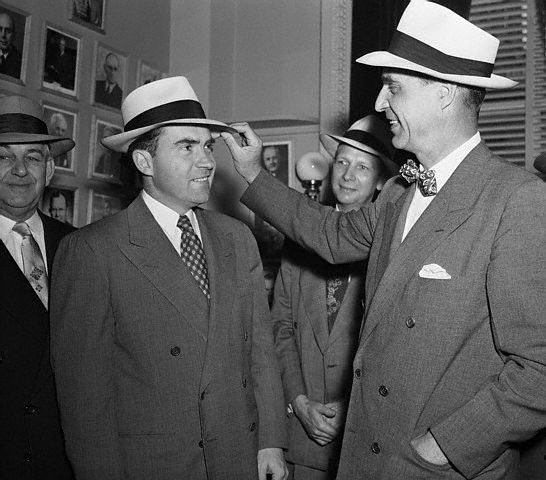
(First term Congressman Dick Nixon, on his way to consult with Prescott Bush.)
March Madness has given way to April Ennui. I may look in at the game tomorrow night, or I may not. The headlines pretty much summed it up for me: “University of Kentucky fans overturn cars, burn couches to celebrate Final Four win over Louisville. I had to look carefully to ensure that it said “couches,” and not “coaches.”
On the other side of the Final Four, Ohio State blew a nine-point lead over Kansas at the half as the game degenerated into full-contact basketball. A pal wrote this morning to say that he turned it off at the 14:00 mark in the second half. Someone would be left standing at the end of it, and he said he just didn’t care who it was.
My brackets got busted in the first round- I was one-and-done- and never did manage to dredge up much interest in the rest of the tourney. Maybe I will watch the final, and maybe I won’t.
I have been so irritated with the politics of the current cycle that I had to go back to the days of the Red Scare just to take a break.
Then things got worse. I may have to drop this line of inquiry and exploration because my head might pop.
I mean, Senator Joe McCarthy has been thoroughly demonized, not that there wasn’t reason to dislike him, but it turns out that there actually were commies under the beds. Or, at least if not under them, they were sleeping in them.
The VENONA decryptions of Soviet diplomatic communications done across the street at Arlington Hall suggest there were at approximately 349 Americans who had a covert relationship with Soviet intelligence. At least half of them skated free through the rest of their lives, since fewer than half of these code-names have been matched to true-name identities. The chance to walk through the KGB archives is done. But there is no question that the penetration of the Government was real and pervasive.
Of course it was not just happening here, and there were severly alienated young people in Britain, too. The famous British Cambridge spy ring is typical of the far-ranging damage those traitors inflicted on the West, with the last of them (maybe) finally being revealed as Anthony Blunt, a crashing snob and keeper of the King’s (and Queen’s) paintings and the ‘fourth man’ in the infamous spy ring which included Guy Burgess, Donald Maclean and Kim Philby.
(Anthony Blunt. He returned his knighthood, but there was no official punishment for his treason.)
He was only outed as a traitor, finally, by Margaret Thatcher in 1979. Blunt resigned his knighthood, but otherwise was allowed to continue to live out his life of privilege.
The fame of the Cambridge Group is dwarfed by what was going on across the pond. Alger Hiss is the poster child in my mind for the Communists who came to Washington with the New Deal, and his exposure was plain, public and supported by the then highly classified VENONA messages. But still, the media defended him to his death in 1996 at the ripe old age of 92. George Clooney needed to insert this line into his 2005 film 2005 “Good Night and Good Luck,” attributing the words to the legendary founder of CBS William S. Paley: “Alger Hiss was not convicted of treason. He was convicted of perjury.”
Which parses things a little too fine. Of course he was a spy. Whittaker Chambers explained how it happened, how a generation became convinced that radical change was necessary:
“I had joined the Communist Party in 1924. No one recruited me. I had become convinced that the society in which we live, western civilization, had reached a crisis, of which the First World War was the military expression, and that it was doomed to collapse or revert to barbarism. I did not understand the causes of the crisis or know what to do about it. But I felt that, as an intelligent man, I must do something. In the writings of Karl Marx I thought that I had found the explanation of the historical and economic causes. In the writings of Lenin I thought I had found the answer to the question, ‘What to do?’”
I mean, there is a lot there. As a kid in the 1960s, a lot of it resonates. There was The Bomb, and The War and Racism and Injustice. There was plenty to protest, and we did.
The VENONA decrypts of Soviet diplomatic communications outlines the astonishing scope of the Soviet penetration of the American government in the 1930s. I was reading the transcripts of the 1948 testimony that Whittaker Chambers gave to the much-maligned HUAC. I invite your attention to it- it is young Dick Nixon’s first star turn on the American stage, and he has a passing involvement with our pal Mac, who was assigned to the Intelligence School at Anacostia in the mid 1950s. Nixon submitted his correspondence courses to the school until his obligated service was completed.
The Soviet agents Chambers named had been at work since the late 1920s, first through the OGPU and then NKVD (predecessors to the KGB and now FSB). There were Russians and other foreign-born people involved in the spying, of course, but there were many native-born Americans who believed just what Whittaker Chambers did, and were happy to help.
These agents established various espionage networks and eventually succeeded in penetrating various U.S. government agencies, transmitting classified or confidential information to Moscow while influencing U.S. government officials to support policies favorable to the Soviet Union.
Yesterday, I noted (in passing) that Alger Hiss had been the key policy maker on the Far East prior to the war. He was in a position to undermine Chang Kai-shek in his fight with Communist forces led by Mao.
In his last government job, Hiss was the American negotiator determining the composition of the post war UN General Assembly- and the first acting Secretary General- as a Soviet Agent!
It is plain awesome. Of course, the whole thing was embarrassing to all concerned. Harry Truman was no communist sympathizer, but he knew politics when he saw them.
Running against Dewey in 1948, he called the HUAC hearings a “red herring.” Privately, when the FBI showed him the contents of the Pumpkin Papers that Hiss was providing the Soviets through Chambers, he said called Hiss “a son-of-a-bitch” who was “guilty as hell.” Asked why he said something totally different for public consumption, the president replied, “The Republicans are not attacking Alger Hiss. They’re attacking me.”
The whole thing was too embarrassing.
The Secretary of the Army kept the VENONA secrets from Truman, judging it to be too sensitive for the President of the United States. Imagine what the public might think about a government that had been warned about the security problems in 1937, and not only ignore them, promoted the worst of them. Alger Hiss was a man who sat right behind President Franklin Roosevelt at Yalta, and had supervised Far East policy before Pearl Harbor, served in the Agricultural Adjustment Administration, in the Justice Department, and as counsel to a Senate committee.
These days, if you point out that everything Whittaker Chambers testified about in 1948 was true, and what’s more, he had provided the same information to the Executive Branch in 1939 and was ignored- well, perfectly nice people will sniff and say he was never convicted for espionage, only perjuring himself about it.
There is a reason for that. The statute of limitations had run out on the spying, but not the lies about it.
These days, people shrug. I am surprised we got through it at all.

(Whittaker Chambers testifies to the HUAC in 1948. Alger Hiss is circled to the left.)
Copyright 2012 Vic Socotra
www.vicsocotra.com
Red Scare
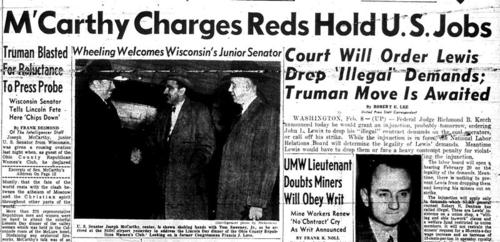
I am supposed to be on an airplane this morning, but I am not.
I had to back out of the big trade show out west because I am not confident in my ability to navigate the tender mercies of the TSA security process with my cane and knee brace, much less horse around a rolling bag and briefcase full of electronic devices.
It is sort of a relief to have made the decision. I took the brace off the knee and almost collapsed in the kitchen last night.
I was sweating in anxiety when I got to the safety of my bed. There needs to be a time of healing, I guess, and this is it.
I am also not sharing the half-billion dollar jackpot on the Meg Millions Lottery, though a co-worker and I had a blissful coffee break contemplating what we would do with the winnings after we each bought ten bucks worth of tickets.
We talked about that at Willow last night after work, left leg dangling in the brace, and the fact that it was considerably more likely to get hit by lightning than it would be to win the lottery. Then we lurched off on the events of the week. The consensus from the right was that Mr. Holder’s Justice Department was nonplussed by the lines of questioning seeking the limit to the Government’s powers under the Commerce Clause. The Solicitor General famously seemed entirely flustered by the concept.
A countervailing word from a more liberal view (and from one who was actually in the chamber) was that the SG didn’t do as badly as the transcripts seemed to indicate. We shall see in June, I suppose.
Old Jim was so irritated by the discourse on Thursday that he staged a boycott Friday night- he sipped his beers at Lyon Hall, the former home of Dan Kain Trophies, a 1930’s example of Old Arlington architecture, a limestone-facade building whose exoskeleton was saved for faux historic value.
I used Dan’s services when I was the junior functionary in the Bureau of Personnel, back when that inestimable institution loomed on the hill over the Pentagon and not on an almost BRAC’d airfield in Tennessee some place.
Willow was busy, and not as much fun as when Old Jim is growling his disapproval of almost everything. He is a Daniel Patrick Moynahan-style Democrat. Old School.
He will follow a logical strand to its end, wherever it goes. Moynahan may have been at his best before lunch, when he was sober, but he was unquestionably a mover and shaker on the Hill, but his formidable intellect had rigor and courage. He spoke the truth about the impact of the dissolving family on the African-American community, noting something identical that is following as that social disintegration is affecting the larger society.
Some things are simple, but the controversy that attended his conclusions reverberates today. The same thing was true about the startling revelations contained in the VENONA transcripts, the existence of which were revealed in his Commission on Government Secrecy in 1995.
Yes, there were Communists under the beds in every walk of the Federal Government, and an unholy alliance between them to steal the secrets that helped us win the war, and then to unsettle the peace and contribute to the ultimate victory of the vanguard of the proletariat.
I was amazed to delve into the life and times of Alger Hiss yesterday. It was a trip to a land that is at once strange and unsettlingly familiar.
John Kenneth Gailbraith is one of those towering intellects who essentially created the conventional wisdom of his age, and ours. He wasn’t right about everything, but his treatment of how Goldman-Sachs, the architect of our melt-down worked in those days long ago is an accurate foretelling of what would come around again in the perfect storm of crony capitalism, bogus home ownership schemes and untrammeled greed.
Galbraith devotes an entire chapter of his seminal tome “The Great Crash: 1929” to the subject of “In Goldman-Sachs, We Trust,” specifying what he called “large-scale corporate thimble-rigging” that the firm (and others) practiced in the 1920s. Primarily, he identifies the “investment trust” vehicles like the GS “Shenandoah” and “Blue Ridge” trusts that never revealed they did (or didn’t) own. Sort of like that scoundrel Bernie Madoff.
Galbraith wrote:
“To reveal the stocks they were selecting might, it was said, set off a dangerous boom in the securities they favored. Historians have told with wonder of one of the promotions at the time of the South Sea Bubble. It was ‘For an Undertaking which shall in due time be revealed’. The stock is said to have sold exceedingly well. As promotions the investment trusts were, on the record, more wonderful. They were undertakings the nature of which was never to be revealed, and their stock also sold exceedingly well.”
And if one hedge fund from the same company was good, then three or 10 or 50 must be better, right? When the inevitable bubble burst, and the margin calls came flying in and the brokers began to fall from the windows, it nearly took down the country.
Change writ large rolled right over prim Mr. Hoover, a good man by all accounts, but overwhelmed with the scope of the disaster that affected every man, woman and child in the country. We got Franklin Roosevelt and his busy battalions of tinkerers.
Alger Hiss was one of them, just one of many.
He was a handsome and likeable fellow by all accounts. In the crash year of 1929, he received his law degree from Harvard, where he had been a protégé of future Supreme Court Justice Felix Frankfurter. The news of that strange roaring decade had been the fundamental basis for the formation of world views- not much different than the 1960s for the Baby Boomers.
The decade of the ‘20s featured some incendiary trials. In 1920, Sacco and Vanzetti, followers of Italian anarchist Luigi Galleani, were busted for armed robbery, and over the next seven years, tried and executed.
Galleani is best remembered for his advocacy of what he called the “propaganda of the deed” in the use of violence to eliminate “tyrants” and “oppressors.”
 (Aftermath of the Wall Street car bombing of 1920 that killed 38.)
(Aftermath of the Wall Street car bombing of 1920 that killed 38.)
They deported his butt back to Italy, but I have stood at the corner in Wall Street where followers of Galleani detonated a bomb that killed 38 people. It is pretty impressive as an act of political theater with the blood of real people. They even used a sort of a prototypical vehicle-borne IED.
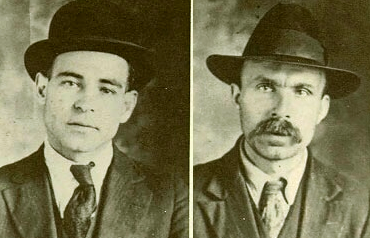
(Sacco, left, and Vanzetti before their two trials and eventual execution)
Sacco and Vanzetti were accused of being the triggermen in a robbery of a shoe factory in Braintree, Massachusetts in the same pivotal year of 1920. Their trial and execution became a cause celebe. Frankfurter wrote a book about the case, and he was joined in opinion by many prominent liberals of the day, (including Hiss) that the duo was unjustly convicted.
It was a time that favored the development of radical views. World War One’s victory parade was only a year past, the old empires were teetering, and a proud red flag waved over the Kremlin in Moscow. The Spanish Flu had swept the West in two devastating waves with the returning troops, killing as many as a half million Americans- that in a population of slightly over one hundred million.
The world held an ominous visage between the ravages of a disease with an impact more profound than the Black Death and the astonishing consequences to the old order of four years of full-out industrial warfare.
Later, in 1924, as the financial bubble swelled and the decade roared, Chicago rich kids Leopold and Loeb killed for the thrill of it, stoking public angst about the amoral nature of vast wealth. Hiss then served for a year as clerk to Supreme Court Justice Oliver Wendell Holmes (a Civil War veteran of the Union, the Greatest generation of the previous century) before joining a white-shoe Boston law firm.
With FDR’s election, Hiss came to Washington to help the New Deal. He was a Justice Department attorney in 1933, before moving to the Hill to assist the Senate Nye Committee, which took WW I War Profiteering as its target. The report of the Committee was highly critical of the conduct of business, and was a contributing factor in the growing sense of American isolationism.
More significantly, Hiss was also a member of the legal team that defended the New Deal Agricultural Adjustment Administration (AAA). The new agency was the “third horse” in the New Deal’s farm relief bill, blending populist easy-money theories with Keynesian economic theory. The idea was simple enough, and had its origins in the “Cross of Gold” speech by the legendary orator and loon William Jennings Bryan. It was also the nexus of the clandestine political connection that changed the course of the nation.
Does this sound familiar? “The Act establishing the AAA said that whenever the president desired currency expansion, he must first authorize the open market committee of the Federal Reserve to purchase up to $4 billion of federal obligations. Should the open market operations prove insufficient the President could additionally have Treasury issue up to $4 billion in greenbacks, reducing the gold content of the dollar by as much as 50 percent, or accept 100 million dollars in silver at a price not to exceed fifty cents per ounce in payment of war debts owed by the cash-strapped Europeans.”
That was back in the days when a big hit in the lottery might have been ten grand, and a billion of anything was almost unimaginable.
Hiss was part of the team that defended AAA against challenges to its legitimacy. Because of intense opposition from agribusiness in Arkansas, the Administration’s team was fired 1935 in what came to be known as “the purge of liberals.” Hiss was not one of the ones let go, but allegations of his radical ties in the legal team would haunt him the rest of his life and land him in the pokey.
(Justice Owen Roberts. Photo Corbis Archives.)
The arguments before the High Court on health care this week bring echoes of what happened then. The AAA was deemed unconstitutional in 1936. FDR’s frustration with the obstructionist court lead to the to the court-packing controversy of 1937, which was resolved only by the switch in allegiance to the New Deal of Associate Justice Owen Roberts. It became known as “the switch in time that saved nine” and the continued existence of an independent High Court.
The AAA was back in 1938 legislation, by the way, and deemed constitutional this time with Owens supporting the Administration position.
By that time, Hiss and his younger brother were working for Cordell Hull at State. In time, Hiss became special assistant to the director of the Office of Far Eastern Affairs as the crisis with Japan deepened. By 1944 he was not only an active Soviet agent, but also Director of the Office of Special Political Affairs, a policy-making entity devoted to planning for post-war international organizations.
If there was a bureaucrat at the middle of everything, Hiss was that creature. He was executive secretary of the Dumbarton Oaks Conference that established the United Nations, attended the Yalta Conference of the Big Three in 1945 to determine the shape of post-war Europe.
Hiss (thankfully) was limited to the United Nations portfolio at Yalta, and drafted a memorandum arguing against Uncle Joe Stalin’s proposal to secure a vote in the new body for each of the 16 Soviet Republics in the General Assembly. In the end, a compromise gave the Soviets three votes: one for the USSR and bonus votes for Ukraine and Byelorus.
I think we should have given Uncle Joe his sixteen, and insisted on one for each of the then-48 states. It would have seemed reasonable, don’t you think? But our negotiator was working for the other side.
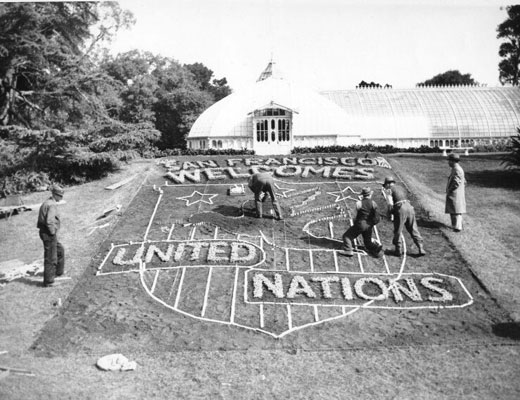
Hiss became secretary-general of the San Francisco United Nations Conference 1945, and then became the full director. In 1946, he left government service to serve as president of the Carnegie Endowment for International Peace, an organization whose charter seeks (in the words of the current promo on National Public Radio) “to promote real and enduring peace.”
He served there until May 5th, 1949, when he was forced to step down due to the conflagration over former Communist Whittaker Chamber’s allegations to the House Committee on Un-American Activities (HUAC) that the AAA defense team had been a cell of active Soviet sympathizers within the Department of Agriculture, and that Hiss was one of them.
Hiss had already denied the whole thing, and the subsequent revelations of Chambers made his eventual conviction on perjury charges highly controversial. In fact, the three years he spent in jail made him the poster boy for the Great Red Scare.
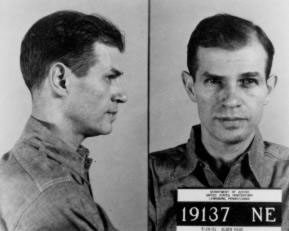
(Alger Hiss mug shot. Photo US Bureau of Prisons).
The political career of a young Richard Nixon began with the hot pursuit of Hiss and the secret Communists of the New Deal. You know where that all wound up.
Sorry to belabor the issue. That all happened a long time ago, but it is the back-story to Mac’s stories of life in Iowa, where the banks were closed, and people had no cash to spend. He says they traded things to get by- a barter economy right here in the USA.
I hope it doesn’t come around to that again, but wouldn’t be ironic if it did, with all the Boomers on the edge of retirement?
Everything old is new again, they say, and feeling as old as I do this morning, and as broke, I am not a bit surprised.
Copyright 2012 Vic Socotra
www.vicsocotra.com
